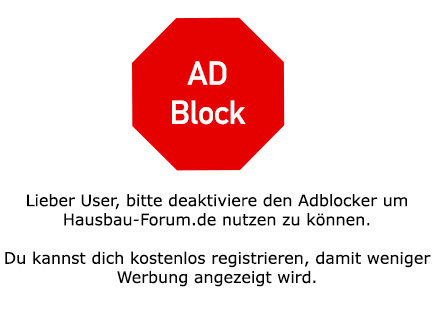Jogidude
2021-08-05 20:25:31
- #1
Hello everyone,
my brother and I are planning the construction of a semi-detached house, one semi-detached half each. The living area should be approximately 110 sqm per semi-detached half and comfortably designed for 1 to 2 people. We each want to live in our own semi-detached half, but also be prepared to rent out or sell one half. We plan to finance separately. A plot of land is available, which can also be divided. We would like to achieve at least KFW55, but preferably KFW40 or KFW40 Plus with a ground source heat pump (deep drilling) with underfloor heating and controlled ventilation.
Now to our considerations and the knowledge we have acquired so far, with no claim to completeness or accuracy. Maybe there are members here who have made similar considerations and would like to help us with their knowledge :)
- Due to the high costs of deep drilling and the heat pump, we are considering using a joint heating system. However, there are several uncertainties here
- For a joint system, is double the number of drillings necessary, so that the savings on drilling do not apply? From drillings nearby, I know they were carried out up to almost 200m.
- The heating room must be accessible to both parties, which must also be registered in the land register. The room must be located in the "warm area" and may not breach the fire protection measures between the residential units.
- Additional costs must be billed based on consumption by law, so the costs per semi-detached half would have to be recorded for heating and hot water. The heat pump requires a separate electricity meter in order to obtain a discounted electricity tariff.
- If the heating is operated "predominantly," i.e., more than 50%, with renewable energies, a flat-rate billing is also possible.
- Preferably coupling the heat pump to a photovoltaic system, but the system must be registered to one of the two parties or can it also be operated jointly?
- Dimensioning of the heat pump and the water storage. Heat pumps operate less efficiently in the lower range, i.e., in the transitional phase of spring/autumn, which could be more problematic with a larger system?
- Since both semi-detached halves are not completely independent of each other, banks could have a problem with separate financing because the semi-detached halves cannot be sold independently.
We are fully aware that a single person cannot have the right answer to all points, but maybe everyone who has already dealt with one or the other topic would like to provide us with a little input. And please feel free to correct me if any statement is incorrect :)
Many thanks in advance and best regards!
my brother and I are planning the construction of a semi-detached house, one semi-detached half each. The living area should be approximately 110 sqm per semi-detached half and comfortably designed for 1 to 2 people. We each want to live in our own semi-detached half, but also be prepared to rent out or sell one half. We plan to finance separately. A plot of land is available, which can also be divided. We would like to achieve at least KFW55, but preferably KFW40 or KFW40 Plus with a ground source heat pump (deep drilling) with underfloor heating and controlled ventilation.
Now to our considerations and the knowledge we have acquired so far, with no claim to completeness or accuracy. Maybe there are members here who have made similar considerations and would like to help us with their knowledge :)
- Due to the high costs of deep drilling and the heat pump, we are considering using a joint heating system. However, there are several uncertainties here
- For a joint system, is double the number of drillings necessary, so that the savings on drilling do not apply? From drillings nearby, I know they were carried out up to almost 200m.
- The heating room must be accessible to both parties, which must also be registered in the land register. The room must be located in the "warm area" and may not breach the fire protection measures between the residential units.
- Additional costs must be billed based on consumption by law, so the costs per semi-detached half would have to be recorded for heating and hot water. The heat pump requires a separate electricity meter in order to obtain a discounted electricity tariff.
- If the heating is operated "predominantly," i.e., more than 50%, with renewable energies, a flat-rate billing is also possible.
- Preferably coupling the heat pump to a photovoltaic system, but the system must be registered to one of the two parties or can it also be operated jointly?
- Dimensioning of the heat pump and the water storage. Heat pumps operate less efficiently in the lower range, i.e., in the transitional phase of spring/autumn, which could be more problematic with a larger system?
- Since both semi-detached halves are not completely independent of each other, banks could have a problem with separate financing because the semi-detached halves cannot be sold independently.
We are fully aware that a single person cannot have the right answer to all points, but maybe everyone who has already dealt with one or the other topic would like to provide us with a little input. And please feel free to correct me if any statement is incorrect :)
Many thanks in advance and best regards!
